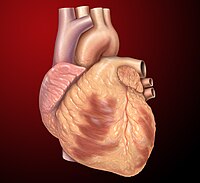
Photo from wikipedia
Abstract Objective This study examined the effects of abdominal bracing maneuver (ABM) performance on stable and unstable surfaces on active forward reach (AFR) distance as a measure of trunk control,… Click to show full abstract
Abstract Objective This study examined the effects of abdominal bracing maneuver (ABM) performance on stable and unstable surfaces on active forward reach (AFR) distance as a measure of trunk control, measuring changes in reach distance and muscle activation patterns. Design Single-group, repeated measures design. Methods Twenty-eight subjects (mean age 25 ± 5.09 years) performed an AFR with and without ABM while on stable and unstable surfaces. Lower quarter muscle activity and forward reach distances were recorded. Results Forward reach distances on the unstable surface were significantly decreased compared to the stable condition with and without ABM (p Conclusion Reach distances decreased on the unstable surface, but ABM did not change reaching distance. Ankle muscle co-contraction occurred during ABM trials and posterior chain activity increased. These changes suggest ABM may be beneficial during forward reaching activities.
Journal Title: Journal of Bodywork and Movement Therapies
Year Published: 2021
Link to full text (if available)
Share on Social Media: Sign Up to like & get
recommendations!